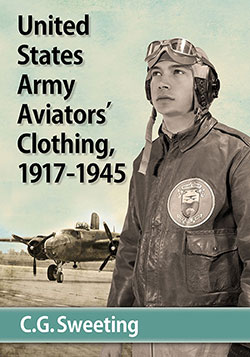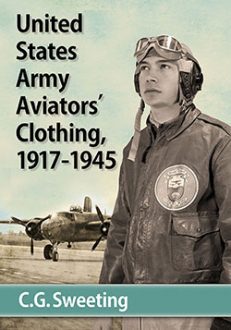United States Army Aviators’ Clothing, 1917–1945
$39.95
In stock
About the Book
The beginning of World War I saw thousands of army and navy aviators who needed specialized clothing that could not be purchased off-the-shelf. During World War II pilots and crews flew countless missions in extreme conditions, from the Arctic to the South Pacific. Through both wars, providing suitable clothing to personnel aboard many different types of aircraft proved a monumental task. This book documents the development, testing, manufacture, procurement and utilization of flying apparel and accessories worn by American airmen around the world between 1917 and 1945. Among the garments explored are various types of flight suits—including heavy winter shearling suits and electrically heated suits—flight jackets, flotation gear, headgear, handwear and footwear. With appendices that include contemporary brochures detailing the care and maintenance of flight clothing, this study provides a thorough exploration of a rarely examined aspect of military history.
About the Author(s)
Bibliographic Details
C.G. Sweeting
Format: softcover (7 x 10)
Pages: 188
Bibliographic Info: 165 photos and illustrations, appendices, notes, bibliography, index
Copyright Date: 2015
pISBN: 978-0-7864-9396-8
eISBN: 978-1-4766-1809-8
Imprint: McFarland
Table of Contents
Table of Contents
Preface 1
Introduction 3
1. Problems in the Development of Flying Clothing 5
2. The Manufacture and Supply of Flying Clothing 11
3. Research and Testing of Flying Clothing 24
4. Heavy Winter Shearling Flying Suits 32
5. Electrically Heated Flying Suits 43
6. Other Types of Flying Suits 51
7. Other Items of Body Clothing 68
8. Headgear 87
9. Handwear 108
10. Footwear 119
Appendices
A. “Program of the Personal Equipment Laboratory,” The Personal Equipment Officer 2, no. 2 (c. 1946), p. 1. 134
B. “Kit, Clothing and Equipment, Flyer,” Technical Order no. 00-30-41, Headquarters, Army Air Forces, Washington, D.C., April 16, 1942. 135
C. “Kit, Flyer’s Clothing and Equipment,” Technical Order no. 00-30-41, Headquarters, Army Air Forces, Washington, D.C., October 20, 1945. 137
D. “Clothing—Refinishing Sheep Shearling Type Flying Clothing,” Technical Order no. 13-1-10, Headquarters, Army Air Forces, Washington, D.C., October 16, 1943. 147
E. “Preliminary Tests on Durability of Flying Clothing” Memorandum Report no. ENG-49-695-2S, Aero Medical Laboratory, Materiel Command, Wright Field, Ohio, April 12, 1944. 149
F. Type Designation Sheets, Wright Field, Ohio, 1920s through World War II. 154
G. The Preservation of Vintage Flying Clothing and Accessories. 160
Abbreviations 168
Notes 170
Bibliography 175
Index 177
Book Reviews & Awards
“detailed account of the creation and changes in flying clothing from the Great War through World War II. This book describes everything from headgear and hand protection to underwear and footwear”—H-Net Reviews; “essential”—ARBA; Reviews of the first edition: “the first volume devoted to the development, manufacture, and use of American flying clothing before and during the war…. Over 150 detailed photographs, many of them never before published, will help the book’s user to identify types of suits, jackets, headgear, handwear, and footwear”—Air Classics Monthly; “destined to be the definitive reference on this subject for both the military historian and the collector”—Air Force Magazine; “this specialized book will be of most interest to the collector, the historical researcher and to those few 8AFers who must have everything written, which is remotely related to the 8th AF experience”—The Eighth Air Force Historical Society.





